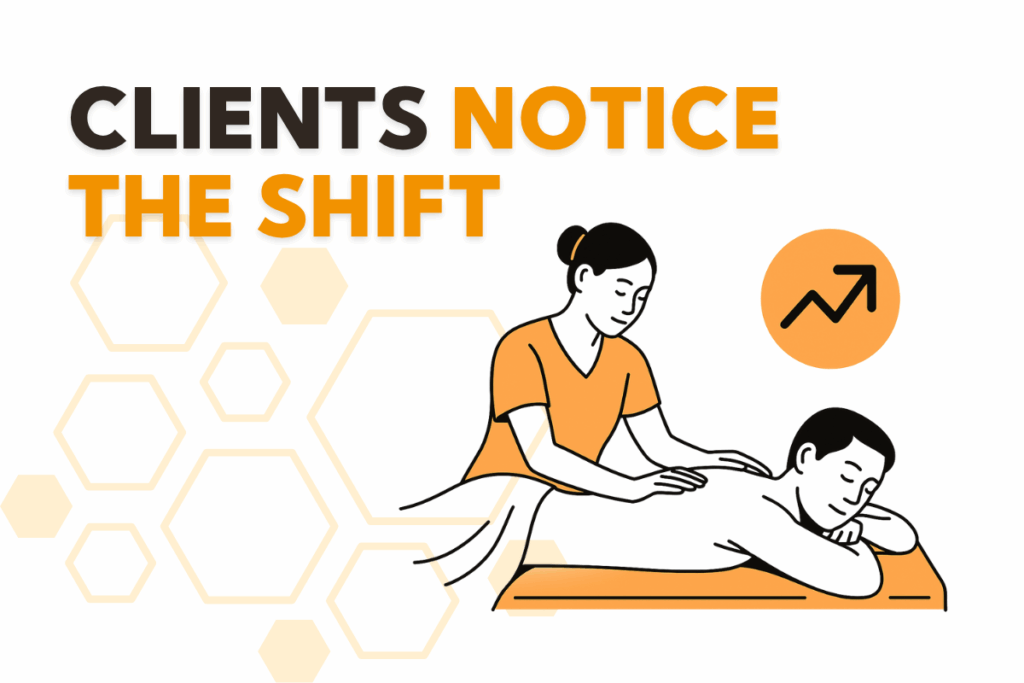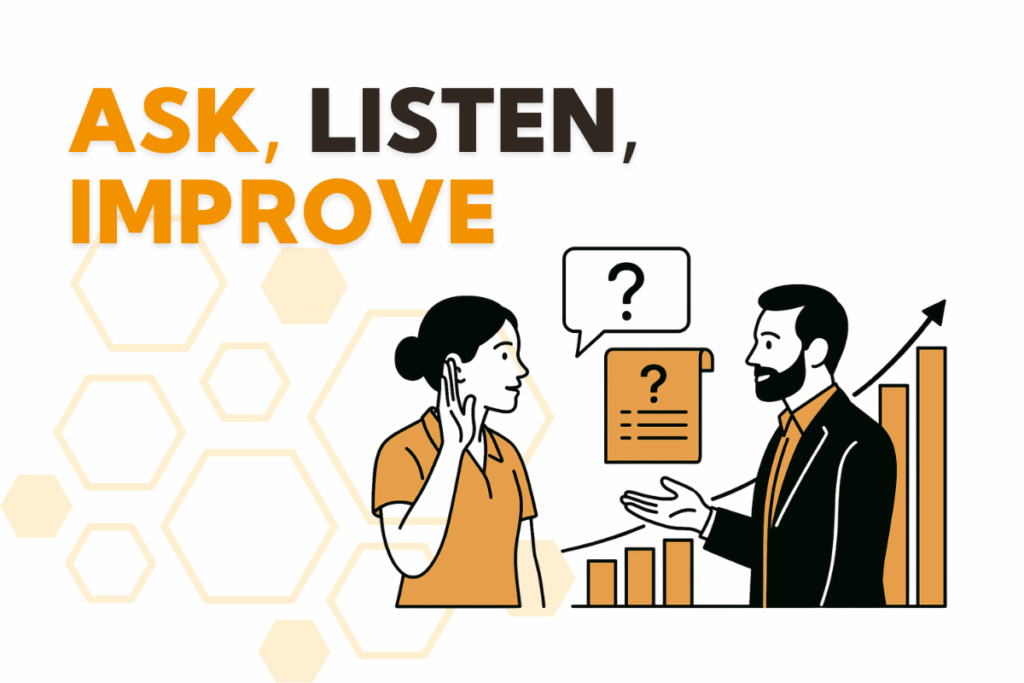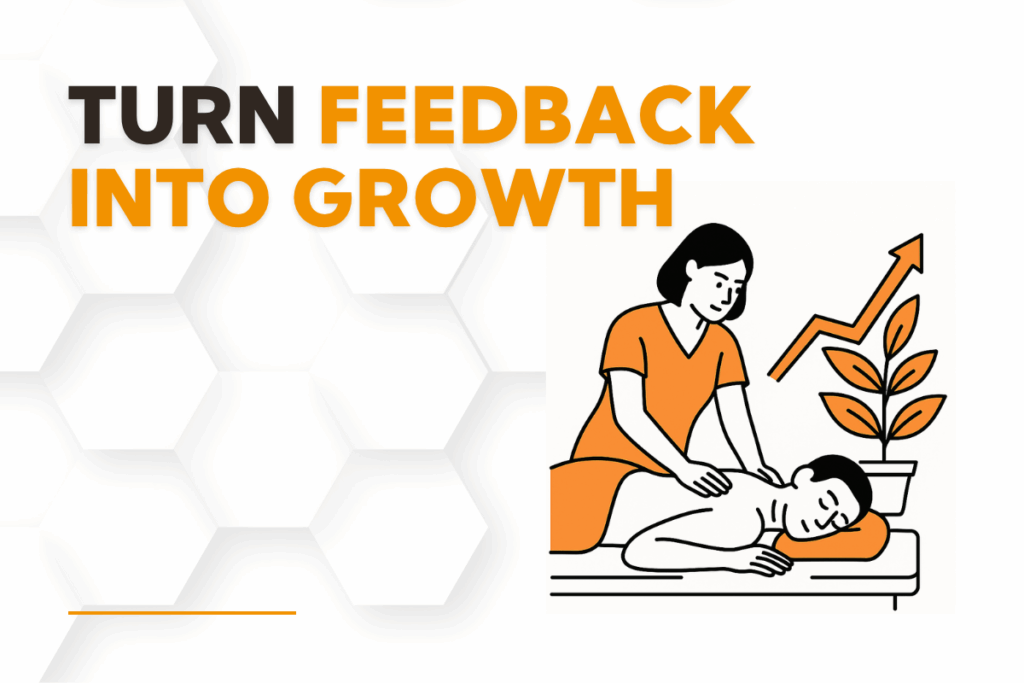Create Space for Honest Feedback Without Losing the Human Touch
Encouraging client feedback in massage clinics isn’t just helpful—it’s essential for delivering exceptional care, building loyalty, and sustaining growth. You can invest in the most skilled therapists, design a calming, high-end environment, and streamline your operations with the best booking tools—but without consistent, honest input from your clients, you’re operating with a blind spot. What’s going well? Where are things falling through the cracks? Why might clients choose not to return, even when everything appears to be running smoothly? Without feedback, you’re left guessing.
A Microsoft study revealed that 77% of consumers view businesses more favorably when they actively seek and act on feedback—and in a hands-on, high-trust industry like massage therapy, that sentiment carries even more weight. Yet, creating space for real feedback can be tricky. Clients may be hesitant to critique a deeply personal experience. Therapists may feel defensive. And many clinics simply don’t have systems in place to make feedback easy and judgment-free.
That’s why this article breaks down not just the why, but the how of encouraging client feedback—so you can build a clinic culture where insights flow naturally, improvements happen regularly, and your clients feel truly heard.
Why Clients Aren’t Telling You the Truth
Understanding the Feedback Gap
Massage therapy clients are often hesitant to offer constructive feedback, even when invited. Here’s why:
- Fear of offending the therapist: Clients don’t want to hurt feelings, especially in such a personal setting.
- Unclear expectations: They aren’t always sure what kind of feedback you’re actually looking for.
- No clear method: If there’s no obvious or easy way to provide input, most clients simply won’t do it.
When clients feel uncertain or uncomfortable about speaking up, they tend to default to politeness: a smile, a “thank you,” and then they disappear.
The Risk of Assumed Satisfaction
Clinic owners often mistake a lack of complaints for satisfaction. In reality, that silence can be masking:
- Mild discomfort with pressure or technique
- Dissatisfaction with scheduling, ambiance, or communication
- Unclear policies or pricing confusion
Without encouraging client feedback consistently, you’re flying blind—and potentially losing loyal clients who never say why they don’t return.

Build a Culture Where Feedback Feels Safe
Set the Tone from the Top
If your clinic culture treats feedback as a threat, your team will too. Start by positioning feedback as a gift:
- Talk about it in team meetings as a tool for improvement
- Model humility by inviting input on management practices
- Celebrate small adjustments that come from client suggestions
Normalize Feedback in the Treatment Room
Therapists should be trained to:
- Ask specific questions like: “Was the pressure okay around your neck today?”
- Avoid leading with assumptions (“Everything good?”) that discourage honesty
- Genuinely thank clients for all input, positive or negative
Even subtle shifts in tone and phrasing can help clients feel more empowered to speak up.
Make Feedback Part of the Journey
Rather than treating feedback as a one-time request at the end of a session, integrate it throughout the client experience:
- At intake: Include a section asking what makes a massage great (or not-so-great) for them
- Mid-treatment: Therapists can check in subtly, based on client cues
- Post-treatment: Offer multiple ways to share feedback privately
Collect Feedback Without Adding Friction
Use Multiple Channels for Client Comfort
Different clients prefer different methods of communication. Encouraging client feedback through a variety of options increases response rates:
- Anonymous digital surveys emailed after the appointment
- Quick comment cards at the front desk
- Touchscreen check-ins or QR codes in the treatment rooms
- Follow-up SMS or email with a feedback prompt (integrated through your client software)
These methods allow clients to choose their comfort level while giving you a clearer picture of what’s working.
Keep It Short, Clear, and Focused
Your feedback forms should be easy to complete in under two minutes. Prioritize questions that:
- Are specific: “Did your therapist check in about pressure preferences?”
- Avoid yes/no answers: Use scales or open-ended prompts
- Invite improvement: “What could have made your experience even better?”
Encouraging client feedback doesn’t require long forms—it requires smart, respectful design.
Ask Smarter Questions, Get Better Insights
Go Beyond “How Was Everything?”
Generic questions lead to generic answers. Instead, tailor your questions to reveal patterns. Examples:
- “How comfortable did you feel discussing your needs with your therapist?”
- “Was the environment relaxing and welcoming?”
- “Did the therapist explain aftercare recommendations clearly?”
Match Questions to the Client Journey
Not every client is in the same stage. Encouraging client feedback from:
- New clients: Ask about first impressions, ease of booking, clarity of services
- Returning clients: Focus on consistency, therapist rapport, treatment progress
- Lapsed clients: Inquire about why they stopped returning and what could improve
Segmented feedback helps you identify trends specific to each stage—and tailor your improvements accordingly.
Use Feedback to Improve, Not Just Impress
Make Feedback Actionable
It’s not enough to collect data. Encouraging client feedback only works if you take clear steps to act on it:
- Review weekly: Designate time to review all feedback submissions.
- Track patterns: Highlight recurring comments or issues.
- Assign responsibility: Ensure someone on your team follows up on suggestions.
- Test small changes: Implement tweaks and monitor client response.
Close the Loop With Clients
When clients see their feedback make a difference, they’re more likely to stay engaged. Follow up by:
- Mentioning small changes made due to suggestions (“We added more hooks in the rooms after your note!”)
- Thanking clients in newsletters or on signage (“Thanks to your feedback…”)
- Sharing positive reviews with staff during team huddles
Encouraging client feedback must include a feedback loop that builds trust.

Turning Complaints into Client Loyalty
One Edmonton-based clinic noticed several anonymous survey responses noting that their reception felt “chaotic.” Instead of dismissing the comment, they:
- Added a part-time front desk staff during peak hours
- Adjusted appointment staggering to avoid crowding
- Trained staff to greet walk-ins with more presence
Within two months, repeat bookings rose 12%, and client feedback began highlighting the “calm, organized vibe.” One simple change made a measurable impact—because they prioritized encouraging client feedback.
Keep the Feedback Loop Going
Build It Into Your Systems
Use automation tools like Hivemanager’s client follow-up system to request feedback consistently without manual reminders. With integrated templates, you can:
- Automatically send feedback links after every visit
- Track submission rates by therapist or location
- Spot issues early before they become churn
Recognize and Reward Participation
Encouraging client feedback becomes easier when clients feel appreciated. Offer:
- A chance to win a free add-on or gift card
- A small discount on a future visit
- Public acknowledgment (with permission) for helpful suggestions
These small incentives can significantly increase engagement.
Empower Your Team to Lead With Curiosity
Coach Therapists to Seek Feedback
Feedback isn’t just for management—it’s a professional development tool. Support your team by:
- Training on how to ask non-defensive questions
- Practicing responses to constructive feedback
- Encouraging regular peer-to-peer reviews
A team that embraces growth mindsets will naturally elevate the client experience.
Track Team Progress Over Time
Use your clinic software or a shared dashboard to track:
- Feedback volume per therapist
- Star ratings or satisfaction scores
- Common compliments or concerns
Tie feedback to performance reviews or bonus structures so it becomes part of your operational rhythm. Learn more about using automation to track performance metrics inside Hivemanager.
Moving Forward With Confidence and Clarity
Encouraging client feedback isn’t just a tool for fixing what’s broken—it’s a catalyst for meaningful growth, deeper client relationships, and a more resilient, trust-based clinic culture. When clients feel safe enough to share their honest experiences—and see their feedback lead to real change—it signals that you value their voice, not just their business. That level of respect builds loyalty far beyond a rewards program or marketing campaign.
By implementing simple, reliable systems that make feedback easy and judgment-free, you create an ongoing conversation that benefits everyone: your clients feel heard, your team stays aligned with client expectations, and your clinic evolves with intention. Whether it’s a small tweak to your intake process or a shift in how your team communicates during treatments, every piece of feedback becomes a stepping stone toward a stronger, more client-centered practice.
Every “thank you for your input” is more than courtesy—it’s an investment in long-term success. The more you listen with curiosity and act with care, the more your business will grow—rooted in trust, guided by insight, and powered by the people you serve.
FAQs
The best way is to offer multiple options—such as anonymous digital surveys, in-person check-ins, and QR code prompts—and ensure clients know their feedback is valued and won’t impact future care.
Weekly reviews help you spot trends early, but monthly summaries are useful for evaluating overall performance and making broader adjustments.
Not if you build a culture where feedback is seen as a tool, not a threat. Recognize effort, focus on growth, and avoid placing blame—this fosters resilience and professionalism.
Hivemanager automates feedback requests, tracks submission trends, and integrates insights into client profiles, making it easier to monitor satisfaction and take action without manual work.


